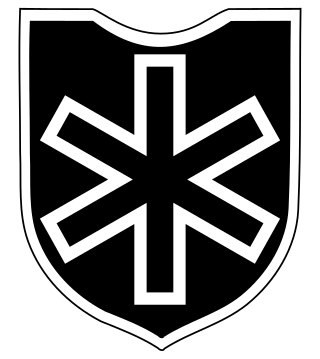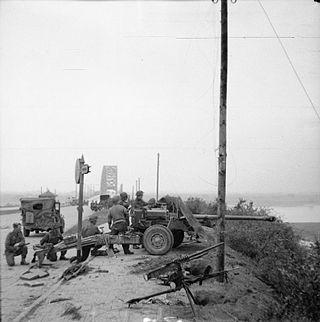History
After his appointment as commander-in-chief of Army Group Upper Rhine, Heinrich Himmler formed the headquarters of the XIV SS Army Corps in November 1944. Because there were not enough combat units available, the corps consisted of only one division, the 553rd Volksgrenadier Division. The force acted as a reserve for the army group.
The corps was given the task of attacking and pinning U.S. Army units at Gambsheim at the start of Operation Nordwind, so that they could not be used as reinforcements against the main attack, which would be deployed more to the north.
In the night of 4 to 5 January 1945, the 553rd Volksgrenadier Division crossed the Rhine near Gambsheim, where the Moder and Zorn rivers merge. Because most U.S. units of VI Corps fought in the north and thanks to the help of the pro-German population, the Germans were able to quickly extend their bridgehead to Kilstett, Herrlisheim, and Offendorf.
General Alexander Patch, commander of the U.S. 7th Army, ordered the newly arrived 12th Armored Division to destroy the bridgehead on 8 January. This attack and a second attack on 13 January failed with heavy losses.
On 14 January 1945, the XIV SS Army Corps received the 3rd SS Panzer Battalion of the 10th SS Panzer Division "Frundsberg", led by SS-Brigadeführer Heinz Harmel. The experienced Harmel ignored the orders of his corps commander and launched an attack on 16 January 1945. His heavy German tanks destroyed a U.S. tank battalion and overran the accompanying armoured infantry. Despite this victory, the German attack stalled. Canals and drainage canals cut through the landscape and many German tanks got stuck or had mechanical problems.
On the southern edge, the 3rd French Infantry Division expelled the 553rd Volksgrenadier Division from Kilstett and by 21 January, the German offensive came to an end.
In the East, the Soviet Vistula–Oder offensive had broken out and several German units were sent from the West to the endangered Eastern Front. The headquarters of the XIV SS Army Corps were dissolved and the staff formed the X SS Corps that was sent to Pommern.

The 14th Armored Division was an armored division of the United States Army assigned to the Seventh Army of the Sixth Army Group during World War II. It remains on the permanent roll of the Regular Army as an inactive division, and is eligible for reactivation. The division is officially nicknamed the "Liberators".

The 6th SS Mountain Division Nord was a World War II mountain infantry division of the Waffen-SS, the military wing of the German Nazi Party, primarily consisting of ethnic Germans along with some Norwegian and Swiss volunteers. It was the only Waffen-SS division to operate in the Arctic Circle.

The Vistula–Oder offensive was a Red Army operation on the Eastern Front in the European theatre of World War II in January 1945. The army made a major advance into German-held territory, capturing Kraków, Warsaw and Poznań. The Red Army had built up their strength around a number of key bridgeheads, with two fronts commanded by Marshal Georgy Zhukov and Marshal Ivan Konev. Against them, the German Army Group A, led by Colonel-General Josef Harpe, was outnumbered five to one. Within days, German commandants evacuated the concentration camps, sending the prisoners on their death marches to the west, where ethnic Germans also started fleeing. In a little over two weeks, the Red Army had advanced 480 kilometres (300 mi) from the Vistula to the Oder, only 69 kilometres (43 mi) from Berlin, which was undefended. However, Zhukov called a halt, owing to continued German resistance on his northern flank (Pomerania), and the advance on Berlin had to be delayed until April.

The 9th Panzer Division was a panzer division of the German Army during World War II. It came into existence after 4th Light Division was reorganized in January 1940. The division was headquartered in Vienna, in the German military district Wehrkreis XVII.

The 12th Infantry Division – later known as the 12th Volksgrenadier Division – was a Wehrmacht military unit of Nazi Germany that fought during World War II. The division was formed in 1934. It participated in the invasion of Poland in 1939 and the 1940 campaign in France and the Low Countries. In the Soviet Union, the division joined Operation Barbarossa. The division was destroyed in the Soviet Operation Bagration in the summer of 1944. The division was re-activated in September 1944 and posted to the newly created Western Front.

The 17th SS Panzergrenadier Division "Götz von Berlichingen" was a German Waffen-SS division that saw action on the Western Front during World War II.

The Battle of Narva Bridgehead was the campaign that stalled the Soviet Estonian operation in the surroundings of the town of Narva for six months. It was the first phase of the Battle of Narva campaign fought at the Eastern Front during World War II, the second phase being the Battle of Tannenberg Line.

The Lvov–Sandomierz offensive or Lvov–Sandomierz strategic offensive operation was a major Red Army operation to force the German troops from Ukraine and Eastern Poland. Launched in mid-July 1944, the operation was successfully completed by the end of August.

The Colmar Pocket was the area held in central Alsace, France, by the German Nineteenth Army from November 1944 to February 1945, against the U.S. 6th Army Group during World War II. It was formed when 6th AG liberated southern and northern Alsace and adjacent eastern Lorraine, but could not clear central Alsace. During Operation Nordwind in December 1944, the 19th Army attacked north out of the Pocket in support of other German forces attacking south from the Saar into northern Alsace. In late January and early February 1945, the French First Army cleared the Pocket of German forces.

The I SS Panzer Corps was a German armoured corps of the Waffen-SS. It saw action on both the Western and Eastern Fronts during World War II.
The Battle of Memel or the siege of Memel was a battle which took place on the Eastern Front during World War II. The battle began when the Red Army launched its Memel offensive operation in late 1944. The offensive drove remaining German forces in the area that is now Lithuania and Latvia into a small bridgehead in Klaipėda (Memel) and its port, leading to a three-month siege of that position.

The Upper Rhine High Command, known for three days as Army Group Upper Rhine, was a short-lived headquarters unit of the German Armed Forces (Wehrmacht) created on the Western Front during World War II. The Upper Rhine High Command was formed on 26 November 1944 and deactivated on 25 January 1945. The sole commander of this headquarters unit was Heinrich Himmler.

Operation Perch was a British offensive of the Second World War which took place from 7 to 14 June 1944, during the early stages of the Battle of Normandy. The operation was intended to encircle and seize the German occupied city of Caen, which was a D-Day objective for the British 3rd Infantry Division in the early phases of Operation Overlord. Operation Perch was to begin immediately after the British beach landings with an advance to the south-east of Caen by XXX Corps. Three days after the invasion the city was still in German hands and the operation was amended. The operation was expanded to include I Corps for a pincer attack on Caen.

Herrlisheim is a commune in the Bas-Rhin department in Grand Est in north-eastern France. The town dates from the 8th century. Herrlisheim was the scene of very heavy fighting during Operation Nordwind, an offensive launched by the German Army during World War II that inflicted considerable damage to the town.
The Wehrmacht forces for the Ardennes Offensive were the product of a German recruitment effort targeting German males between the ages of 16 and 60, to replace troops lost during the past five months of fighting the Western Allies on the Western Front. Although the Wehrmacht was keeping the Allied forces contained along the Siegfried Line, the campaign had cost the Wehrmacht nearly 750,000 casualties, mostly irreplaceable. However, the rapid advance of the Allied armies in August and September after Operation Overlord had created a supply problem for the Allies. By October, the progress of the Western Allies' three army groups had slowed considerably, allowing the Germans to partly rebuild their strength and prepare for the defense of Germany itself. Adolf Hitler decided that the only way to reverse his fortunes would be to launch a counter-offensive on the Western Front, forcing both the United States and Great Britain to an early peace, and allowing the Wehrmacht to shift its forces to the Eastern Front, where it could defeat the much larger Soviet Red Army.

Major General Roderick Random Allen was a senior United States Army officer, who commanded the 20th and 12th Armored Divisions during World War II. Under his command of the 12th AD, the division defended Strasbourg from recapture; it provided the armored contingent in the closure of the Colmar Pocket and the liberation of Colmar; it spearheaded General George Patton's drive to the Rhine; captured intact the remaining bridge over the Danube River and broke the German defense line; and played a major part in blocking the Brenner Pass, thereby trapping over a million German soldiers in Italy as the war ended. En route to the Brenner Pass it overran eleven concentration camps at Landsberg, Germany.
The 61st Rifle Corps was a Red Army infantry corps during World War II, formed twice. The 61st Rifle Corps was formed firmed in Tula during September 1939. After Operation Barbarossa, it was transferred to the front in Belarus and fought in the Battle of Smolensk. After suffering heavy losses at Smolensk, it was disbanded in early August 1941. Reformed in spring 1943, the corps fought in Operation Kutuzov, the Lublin–Brest Offensive and the Berlin Offensive. The corps was disbanded after the end of the war in summer 1945.

The Battle of the Nijmegen salient or the Defence of the Nijmegen bridgehead was a series of engagements that took place in the Netherlands during World War II between 30 September and 8 October 1944. The battle occurred in the aftermath of Operation Market Garden, a failed attempt by the Allies to cut off German forces in the Netherlands and end the war quickly.
The 559th Volksgrenadier Division was a volksgrenadier division of the German Army during World War II that fought entirely on the Western Front.
The 553rd Volksgrenadier Division was a volksgrenadier division of the German Army during World War II that fought entirely on the Western Front.














